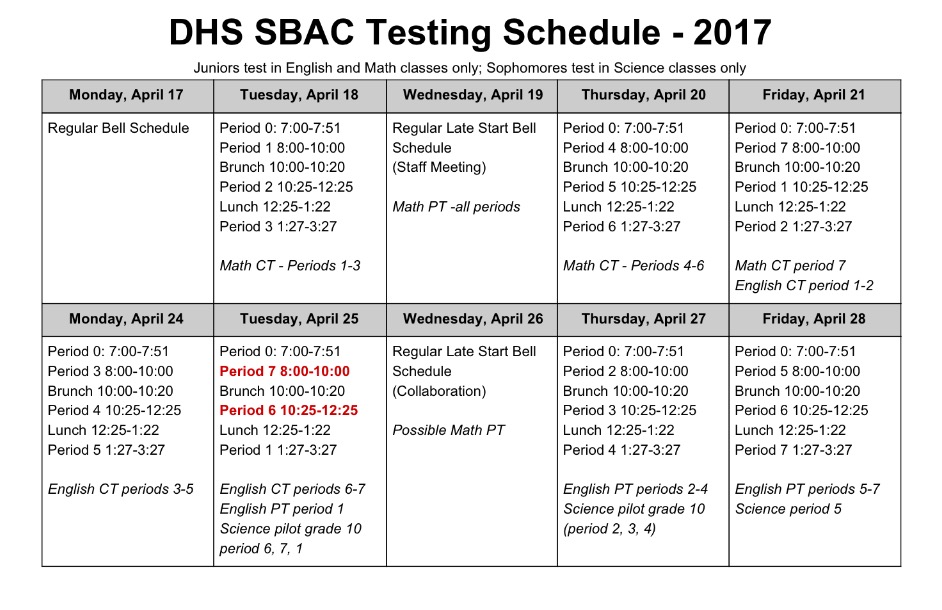DHS reacts to SBAC Block Schedule
A “slip” schedule, which is similar to a block schedule, was implemented for seven days this year to accommodate for the Juniors’ Smarter Balanced Assessment Consortium (SBAC) testing and the sophomores’ Next Generation Science Standards (NGSS) pilot testing. The block schedule began on April 18th and ended on April 28th, with the exception of regular late start bell schedule Wednesday. There were 3 two-hour block periods on each block schedule day, starting at 8 AM for all students, with the exception of students with zero period, who attended class for the usual amount of time on each block day. Each block day had a 20 minute brunch after the first block period class of the day and almost a hour of lunch following the second block period.
This is unlike last year’s schedule adjustment for SBAC testing, where the juniors were tested from 8 AM to 10:15 AM, and all students attended 30-minute classes between 10:30 AM to 3:27 PM for only 4 days. Thus, non-Juniors didn’t have to arrive at school until their first period class at 10:30 AM, nor their zero period at 10:15 AM.
Most of the interviewed students viewed the block schedule in a positive light. “The block schedule offers me a unique opportunity to get more than 5 hours of sleep due to not having a class two consecutive days in a row,” said Yizhen Hou.
“I liked the block schedule because there wasn’t as much homework each night,” commented Sophomore Elizabeth Liu. “I think this block schedule game me less stress because it was only a few classes each day so that meant less homework.”
However, Elizabeth also mentioned that she “disliked how chaotic the block schedule was because it was so different” from the usual seven period schedule. Junior Abbie Yee agreed, “The block schedule wasn’t really bad. It just got confusing on that one day when it [the class period] went from 7 to 5 and 6.”
If the Juniors had a choice to decide which SBAC testing schedule they would have liked to test in, Junior Abbie Yee still preferred SBAC testing in “this year’s SBAC schedule [since it] was better. It [the SBAC testing schedule] felt kind of rushed last year since it was all thirty minute class periods after SBAC testing.” Likewise, Junior Radhiia Girish also preferred this SBAC testing schedule since she got to “switch out between testing and taking [her] usual classes.”
From a teacher’s perspective, Ms. Beck liked the “time to do longer activities [in class] without breaking things up between multiple days (especially good for showing documentaries)”, but she also admitted, “I’m not used to teaching until the end of the day so it throws me off my game!” Ms. Beck remarked, “I personally preferred last year’s [SBAC] block schedule because then I could see my students every day and students who weren’t testing had the chance for more rest (sleeping in and not starting until 10).”
Overall, this SBAC testing block schedule generally received a positive feedback from both the students testing and students not testing. Most students felt that they experienced less stress from their two-hour class periods than the regular bell schedule, which is most likely because they could start on homework during extra time in the extended class period or had more time to work on homework for the classes they did not have the next day.
Your donation will support the student journalists of Dublin High School. Your contribution will allow us to purchase equipment and cover our annual website hosting costs.

Janice Liu is a senior at Dublin High School and the former Copy Editor of the Dublin Shield. She spends most of her time either listening to music...



































